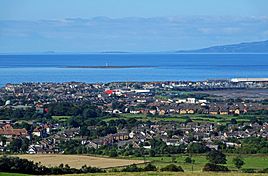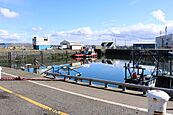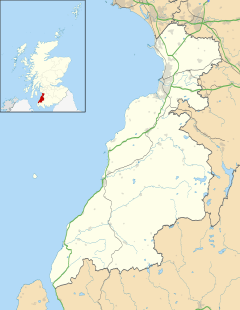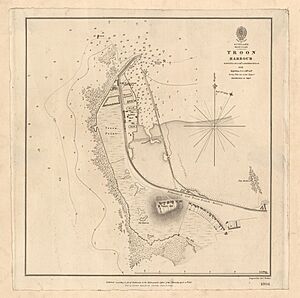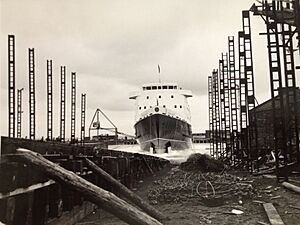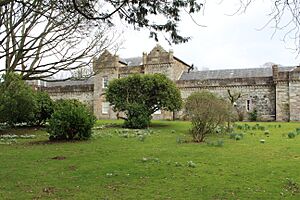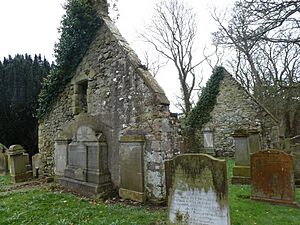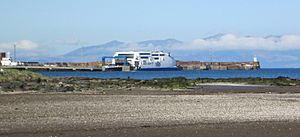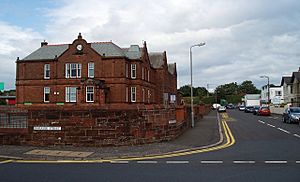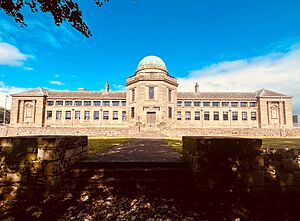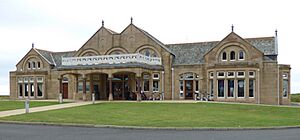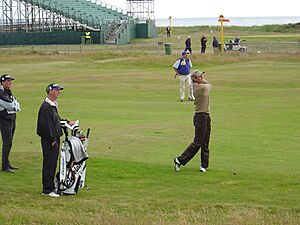Troon facts for kids
Quick facts for kids Troon
|
|
|---|---|
| Town and sea port | |
|
Troon skyline
Town Centre
Troon Town Hall
Marr College
Troon Harbour
|
|
| Population | 14,950 (2020) |
| OS grid reference | NS345255 |
| Council area | |
| Lieutenancy area |
|
| Country | Scotland |
| Sovereign state | United Kingdom |
| Post town | Troon |
| Postcode district | KA10 |
| Dialling code | 01292 |
| Police | Strathclyde |
| Fire | Strathclyde |
| Ambulance | Scottish |
| EU Parliament | Scotland |
| UK Parliament |
|
| Scottish Parliament |
|
Troon is a town and sea port in South Ayrshire, Scotland. It is located on the west coast of Ayrshire, about eight miles north of Ayr. It is also about three miles northwest of Glasgow Prestwick Airport.
Troon has a busy port with ferry and freight services. It also has a place where yachts can dock, called a marina. Until 2016, a ferry service ran to Larne in Northern Ireland during certain times of the year. In 2006, a ferry service to Campbeltown started, but it stopped the next year. Since March 2024, Caledonian MacBrayne has run a ferry service from Troon to Brodick on the Isle of Arran.
In 2001, about 14,766 people lived in Troon. This number included the Barassie area but not the nearby village of Loans. This was a small increase from 1991. By 2024, the population of Troon was just over 15,000 people.
Contents
What's in a Name?
The name Troon probably comes from an old language like Brythonic or Pictish. It is similar to the Welsh word trwyn, which means "nose" or "cape". A cape is a piece of land that sticks out into the sea.
When Scottish Gaelic became the main language, people might have used the Gaelic name An t-Sròn for Troon. This also means "the nose". Since sròn and trwyn are similar words, it was easy to change the name from one language to the other. This is like the Gaelic name for Stranraer, which means "the fat nose".
However, we are not sure if An t-Sròn was the original Gaelic name for Troon. It was first written down in a book about place names in 1932. It is more likely that a Gaelic spelling like An Trùn was used. Gaelic speakers on nearby Arran Island used the name An Truthail for Troon until the 1900s.
Troon's Past
Early Days of Troon
In 1808, the 3rd Duke of Portland decided to improve the natural harbour at Troon. He added docks to it. This was allowed by a special law called the Troon Harbour Act 1808.
The harbour opened in 1812. It was used by the Kilmarnock and Troon Railway to transport coal. Later, more improvements were made to protect the harbour. An artificial "ballast bank" was built from the extra weight (ballast) that ships dumped when they arrived. The Troon Lifeboat Station opened at the harbour in 1871. The land for it was given by the Duke of Portland.
Troon Harbour was very important for the town's growth for many years. It was home to the Ailsa Shipbuilding Company. This company built many ships for people all over the world. Most of these were small passenger ships and other merchant vessels.
The fishing boats from Ayr later moved to Troon Harbour. This helped to bring life back to an unused part of the harbour. A new road was built to connect to a P&O ferry terminal. This terminal offered services to Ireland. A fast ferry service called Seacat also used Troon Harbour for a short time.
Today, Troon Harbour is still a fishing port and a place for yachts. It is also a port for seasonal passenger ferries. It is a Ro-Ro ferry terminal, which means vehicles can drive on and off. It is used for transporting timber and containers. Shipbuilding at Troon Harbour stopped in 2000.
How Troon Grew
From 1812, Troon was the end point of the Kilmarnock and Troon Railway. This was a railway where horses pulled wagons. It connected Troon to the Duke of Portland's coal mines near Kilmarnock. This railway was not officially allowed to carry passengers. However, people found a way around this by weighing passengers and charging them as if they were freight.
Troon's old railway station opened in 1839. It was one of the first passenger stations in Scotland. This happened when the Kilmarnock and Troon Railway was updated to use steam locomotives. Today, the town is served by Troon railway station.
Troon is the birthplace of C. K. Marr. He left money to the people of Troon. This money was used to build Marr College, which is the town's secondary school.
The Duke of Portland had a big plan for Troon. He wanted to build wide streets in a grid pattern. He also wanted plenty of space for public buildings. This confident plan was possible because Troon was becoming very rich from its harbour. The plan showed two tall church spires. The taller one was for Troon Parish Church, but its spire was never finished.
The first railway in Scotland, from Troon to Kilmarnock, opened in 1811. The Glasgow and South Western Railway changed the town's plan in 1892. They built a loop to bring passengers closer to the beach. A large park was planned but never built. However, there are still public spaces along the promenade and other areas for people to enjoy.
Fullarton House
Fullarton House was built in 1745 by William Fullarton. It was changed by his son. However, the house was pulled down in 1966 by the local council. They had bought it in 1928 but could not afford to keep it up.
The Duke of Portland had changed the entrance to the house. He also changed its design so that the back became the front. This opened up amazing views of the Isle of Arran and the Firth of Clyde. The Fullarton family had owned the property for centuries. But in 1805, the 3rd Duke of Portland bought it. He lived there for a while as his main home in Scotland. However, he was more interested in developing Troon harbour and the Kilmarnock and Troon Railway.
Today, the grounds of Fullarton House are a park. You can still see some signs of the old house. These include the large stable block, decorative stone carvings, walled gardens, a dovecote (a building for pigeons), and an ice house. An old loch called Reed Loch was once nearby. It was later used for curling.
The Fullarton Family
The Fullarton name might come from the job of 'Fowler to the King'. This person had to supply wild birds to the King. The home that came with this job was called Fowlertoun. The family might have later taken this name.
Alanus de Fowlertoun owned the land around 1280. The family continued to own it, usually passing it from father to son. William Fullarton, who built the house, inherited the estate in 1710. Colonel Fullarton, the last Fullarton laird, died in 1808. He wrote an important book in 1793 about farming in Ayrshire. He was one of the few people who praised Robert Burns's farming skills. Burns is said to have visited Fullarton House.
Crosbie Castle
Crosbie Castle was given to the Fullarton family in 1344. By the 1700s, parts of the old castle were pulled down. It was then turned into an ice house for Fullarton House. A dovecote was built nearby. In 1969, more of the ice house was removed to make it safe. The building was known as Crosby Place and later Fullarton House, before the new Fullarton House was built.
Over many years, the castle was rebuilt three times. It had the same square design as Dundonald Castle. What remains today is mostly the castle's dungeon. Many stones from Crosbie Castle were used to build the first Fullarton House. The dungeon had an underground stream, which made it a perfect cold storage cellar or ice house.
Crosbie Church and Cemetery
Crosbie Church was first mentioned in 1229. The building you see today dates from 1691. A story says that the roof blew off on the day Robert Burns was born in 1759. After that, it was left to become a ruin.
One of the graves there belongs to David Hamilton of Bothwellhaugh. He was the son of James Hamilton, who was said to have killed the Regent Moray in 1570. David died in 1619. David Fullarton of that Ilk had married David's sister.
The church was built where an older chapel once stood. The name 'Crosbie' comes from an old word meaning "dwelling of the cross". The cemetery dates back to about 1240. It was owned by the Fullarton family in the 1300s. Records show that a holy group used this land before the Fullartons arrived.
The cemetery was the main burial ground for Troon until 1862. Families continued to use their burial plots there until after the First World War. Across the road, you can still see the remains of the church's old house (manse). The 'Wrack Road' was a road used by tenants of the Fullarton Estate. They took their carts to the shore to collect seaweed (or wrack) to use as fertilizer. It was also the main road from Troon for funerals going to Crosbie.
Troon's Economy
Troon is very famous for its golf courses. The Royal Troon golf course is one of the places that hosts The Open Golf Championship. This big event happens there about every seven years. It will host the championship again in 2024.
SeaCat started passenger ferry services from Troon to Ireland in 1999. They used fast catamaran ferries. P&O Irish Sea followed them in 2003. SeaCat closed the next year. Until 2015, P&O Ferries ran seasonal trips with their fast catamaran, the HSC Express. People often called the P&O service "SeaCat". P&O announced in January 2016 that their Troon–Larne service would close right away. The old SeaCat terminal is now fenced off and used to store logs.
The ferry terminal in Ardrossan was being expanded and renovated. During this time, the ferry terminal at Troon was used by Caledonian MacBrayne. They used it for ferries going to Brodick on the Isle of Arran. In March 2024, Caledonian MacBrayne said they would try docking the ship MV Isle of Arran at Troon Harbour. If it worked, the ship would start more trial trips from Troon to Brodick.
Learning in Troon
Troon has five primary schools. Four of them are not linked to a specific church: Troon Primary School, Muirhead Primary School, Struthers Primary School, and Barassie Primary School. One primary school, St. Patrick's Primary School, provides Catholic education.
Younger children can go to early years centres. These are a mix of private places and local council places attached to primary schools. Marr College is the only secondary school in Troon. It is run by South Ayrshire Council. Students who go to Catholic primary schools usually move on to Queen Margaret Academy in nearby Ayr. This is because Troon does not have a separate Catholic secondary school.
After-school care in Troon is also a mix of private places and one local council club. The council club is based at Muirhead Care Club in the Muirhead area of town.
Early Years Centres
- Troon Early Years Centre
- Barassie Early Years Centre
- Muirhead Early Years Centre
- Struthers Early Years Centre
- Granny Smiths Nursery (private, works with South Ayrshire Council)
- Meadowgreen Pre-School (private, works with South Ayrshire Council)
- Marina View Nursery
Primary Schools
- Troon Primary School
- Barassie Primary School
- Muirhead Primary School
- Struthers Primary School
- St. Patrick's Primary School
Secondary Schools
- Marr College
Further Education Near Troon
Troon itself does not have colleges or universities. However, there are several options nearby:
Ayrshire College
Ayrshire College offers many courses. These include vocational qualifications and higher national certificates. They have campuses in:
- Ayr
- Kilmarnock
- Kilwinning
Universities Nearby
You can find universities in the areas around Troon:
- University of the West of Scotland (UWS): This university offers courses for both undergraduate and postgraduate students. It has campuses in Ayr, Paisley, Hamilton, and Dumfries.
- Glasgow Universities: The city of Glasgow has several well-known universities. These include the University of Strathclyde, Glasgow Caledonian University, and the University of Glasgow. They are known for their great teaching and research.
These places offer many different ways to continue your education and achieve your career goals.
Sports and Fun in Troon
Troon is probably most famous for its golf courses. But it also has a strong sports culture in other areas. These include windsurfing and kitesurfing.
Troon Handball Club is a handball club in Troon. It started in 2008. The club has two senior teams, one for men and one for women. Both teams are coached by Stephen Neilson, who used to be a Scottish and British handball player. Both the men's and women's teams play in the top league of the Scottish Handball Association. The club also has a growing junior section for younger players. They work closely with Marr College, the local secondary school. The club has won Scottish schools and junior Scottish Cup championships many times.
Troon F.C. is the main football team in the area. They play in the West of Scotland Football League. Their home ground is Portland Park, which is close to the town centre. Another important sports team is Troon Dundonald A.F.C. This club was formed in 1983. They have been playing in the Ayrshire Amateur Football Association for over 30 seasons.
The club has changed its name a few times. This was sometimes because of sponsors. But in the 1998/99 season, they decided on Troon Amateurs Football Club. The club's President, Stuart Urquhart, is still one of the original founders. He is still very passionate about the club and amateur football.
Since they started, they have been promoted three times in a row. This happened from 1983-1984 to 1985-1986. This meant they went from the fourth division to the first division of Ayrshire's Amateur Leagues. This is one of the biggest and toughest amateur leagues in Scotland.
Famous People from Troon
- Margaret Allan, a racing car driver
- Ronni Ancona, an actress
- Tom Brighton, a footballer
- Gordon Brown, a rugby player
- George Brown, a professional footballer and businessman
- Gordon Burns, a footballer
- Robert Carrick, a cricketer
- Fiona Caldicott (1941-2021), a psychiatrist and psychotherapist. She was also the former head of Somerville College, Oxford.
- Neill Collins, a footballer
- Andrew Cotter, a BBC Sports broadcaster
- George Hunter, a footballer
- Scott Manley, a science communicator
- Michael McKean, author of Vodka & Spirits: A Short Scottish Ghost Story
- Duncan Lunan, a science fiction writer
- Thomas O'Ware, a footballer
- Rory McKenzie, a footballer who plays for Kilmarnock Football Club
- Dick McTaggart, a boxer
- John Mason, (now deceased) who helped start and lead the Scottish Fiddle Orchestra
- Rognvald Mason, son of John Mason, a lawyer and a founding member of the Scottish Fiddle Orchestra
- Colin Montgomerie, a golfer
- Jamie Ness, a footballer
- Steve Nicol, a footballer
- D'Arcy Rae, a rugby player
- Bill Thomson, a right winger for the Detroit Red Wings ice hockey team
- Brian Whittle, an athlete
- Susannah York, an actress
Twin Towns
Troon is twinned with Villeneuve-sur-Lot, Nouvelle-Aquitaine, a town in France.
See also
 In Spanish: Troon (South Ayrshire) para niños
In Spanish: Troon (South Ayrshire) para niños


